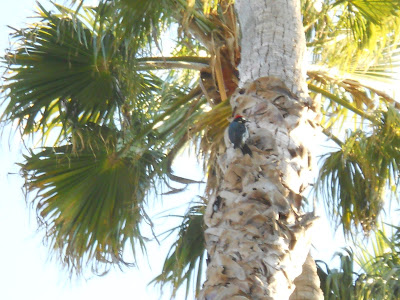I found myself making a trip to Santa Barbara, California, to be with my father during a minor medical procedure. This trip gave me a chance to refamiliarize myself with the species I knew when I was younger. Being nearly 1300 miles (about 2000 km) south of Bellingham, Washington, I was suddenly seeing very different ecosystems: oak groves, coastal chaparral, and non-native shrubs and trees everywhere. The smells were different, too. Instead of cedar, spruce, and fir, the aromas of coastal sage (Artemesia), Bay Laurel, and Eucalyptus were in the air.
Near the Santa Barbara Airport, there is a marine, tidal estuary, or as the locals call it, a slough. I like the Spanish world, estero, better. There, I met Robert Funai, who is working on restoring the salt-loving herbs that grow by the 'lagunas'. Rob works for a Santa Barbara based, ecosystem restoration group. Here, he is pulling invasives from areas where the natives are just getting established.
I met two cyclists at this estuary who had just seen the winter migration grounds of the Monarch Butterfly. When I had time, I went up the coast to Elwood to see the butterflies' winter home. It is a eucalyptus grove on the bluffs above the Pacific Ocean. Many Californians think that the eucalyptus is a native tree. In reality, it was imported from Australia and planted to be a lumber crop and windrows for orchards. It spread. Now the Monarchs have found that some of these groves give them a perfect microclimate and shelter. As the native California Live Oak (Quercus agrifolia) loses ground to development, the Monarch's have shifted to using this Australian transplant. There are winter butterfly groves in Pacific Grove (Monterey), Elwood (Santa Barbara), and Ventura, California.
Entering this stand of Eucalyptus trees, I saw the Monarchs were clustered in masses of hundreds on the tree branches. Their wings are folded up, so that the bright orange of the upper wings was mostly hidden.
Monarchs started to fly from their 'huddle', as the day warmed. Here, you can see the bright orange of there upper wing surfaces. Due to the nature of my trip, I only had a simple point and shoot camera.
Migration Routes of the Monarch Butterfly.
I had a plane to catch, so my brief visit with these intrepid travelers came to an end.
SANTA BARBARA - PART II: EGRETS, PELICANS, AND ACORN WOODPECKERS
I managed to get to the Commercial Fishing Harbor to do some bird watching. I was immediately struck by the behavior of the Snowy Egrets. They were hopping around on the fishing boats. Go where the food is!
SNOWY EGRET (Egretta thula)
These birds, so shy in the estuaries near the airport, were quite bold in the harbor. Here we see a Snowy Egret perched on the trawler winch at the boat's stern. In the foreground, is an immature Herring or California Gull.
Their normal habitat is marsh land and estuaries. They are clearly adapting to the 'easy life', provided by the fishing boats.
I found their antics quite amusing.
At the harbor, there were also Double-Crested Cormorants fishing and sunning themselves.
AND THERE WERE PELICANS.
To me, there is nothing more graceful than a flight of Brown Pelicans.
I lived in California during the days when DDT had decimated the Pelican population. There was a real possibility of extinction. Every time I see a pelican, it makes me glad.
ACORN WOODPECKERS: The beaches are lined with non-native palms. I was truly shocked to see clusters of Acorn Woodpeckers on these trees. They seemed to be delicately working the boles of the trees for (probably) insects and mites. I saw up to four of them on one palm. Their 'normal' behavior is to drill holes in oaks and tuck acorns into the holes. The acorns become incubators for insect larva,which the woodpeckers eat.
I went to one of the few remaining natural oak groves in Santa Barbara, at Rocky Nook Park...looking for Acorn Woodpeckers. I found just one.
They all seemed to be down at East Beach and Henry's Beach at 'the Palms'.
It was time for me to head back home. My father was doing well and I missed my wife. I also longed to see some snow. Today, as I write this, there is a steady snowfall in Bellingham.


















